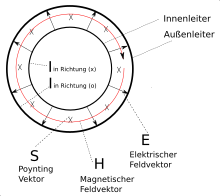Poynting vector
The Poynting vector (named after the British physicist John Henry Poynting ) characterizes in electrodynamics (a branch of physics ) the density and the direction of the energy transport (energy flux density) of an electromagnetic field . The term energy flow is identical to the physical term power , the term energy flow density is therefore equivalent to power density .
The Poynting vector is considered in Poynting's theorem , a conservation law of electrodynamics.
Mathematical description
The Poynting vector is a three-component vector that points in the spatial direction of the energy flow. It is calculated as the cross product of the electric field strength and the magnetic field strength :
The following applies in a vacuum
with the magnetic field constant and the magnetic flux density .
Its amount corresponds
- on the one hand the power density (or intensity ) of the field (the energy which per unit of time passes through a unit area perpendicular to the Poynting vector):
- SI unit:
- on the other hand, the momentum density of the field (the momentum stored per unit volume in the electromagnetic field) multiplied by the square of the speed of light :
- SI unit:
The Poynting vector describes three of the ten independent components of the energy-momentum tensor of the electromagnetic field in the theory of relativity .
Examples
TEM waves
In the case of transverse electromagnetic waves (TEM waves), the power density is given by
where is the wave resistance of the vacuum .
In the above equations, the field sizes are meant to be time-dependent.
For the time average value of the power density over a period, the following applies
With
- the effective value
- the amplitude of a sinusoidal electric field strength :
In isotropic optical media, the Poynting vector is parallel to the wave vector . In anisotropic optical media, e.g. B. birefringent crystals , this is generally not the case.
Energy propagation in the coaxial cable
Typical operation of a coaxial conductor occurs at wavelengths that are greater than the diameter of the coaxial conductor. In this frequency range , which typically extends from 0 Hz to the single-digit GHz range, the energy spreads in the coaxial line as a TEM basic mode . The associated field line image then looks like the adjacent image.
In an ideal-typical view, the Poynting vector only assumes a value other than zero in the area between the outer conductor and inner conductor; In the metallic inner conductor the Poynting vector disappears because the electric field strength is zero, outside the coaxial conductor the Poynting vector disappears because the magnetic field vector is zero here. This is in turn due to the fact that the effects of the electrical currents in the inner and outer conductors cancel each other out.
According to Poynting's theorem , the Poynting vector indicates the direction of propagation of the electrical power . Due to the disappearance of the electric field strength in the metal, the Poynting vector points exactly in the longitudinal direction of the coaxial conductor. This means that the energy propagation in the coaxial conductor takes place exclusively in the dielectric . Since Poynting's theorem can be derived from the general field equations without restriction on the frequency range (cf. Simonyi), this statement also applies to the transmission of electrical power with direct voltages and currents .
The behavior of a resistive conductor can also be explained in the field model. The following illustration is based on the coaxial conductor shown in the picture: If the metallic conductor has a finite resistance other than zero, the current flow in the conductor creates an electric field in accordance with Ohm's law . This field points in the inner conductor in the longitudinal direction (x) of the conductor and in the sheathed conductor in the opposite direction (o). The changed field distribution has the effect that the electric field in the dielectric also has a component in the longitudinal direction. The Poynting vector S, which is orthogonal to E and H , therefore has a radial field component that describes the transition of the lost energy into the metal .
Poynting vector for static fields
The consideration of the Poynting vector in static fields shows the relativistic nature of Maxwell's equations and enables a better understanding of the magnetic component of the Lorentz force .
To illustrate this, consider the picture on the right: it describes the Poynting vector in a cylindrical capacitor that is located in an H-field that is generated by a permanent magnet . Although only static electric and magnetic fields are present, the calculation of the Poynting vector results in electromagnetic energy flowing in a circle, to which an angular momentum can be assigned. It is the cause of the magnetic component of the Lorentz force that occurs during discharge. During the discharge, the angular momentum contained in the energy flow is reduced and transferred to the charges of the discharge current. The apparently senseless and paradoxical result of the circling energy flow turns out to be absolutely necessary in order to do justice to the law of conservation of angular momentum . (Other static examples: see Feynman)
See also
Individual evidence
- ↑ K. Simonyi: Theoretical electrical engineering. 5th edition, VEB Deutscher Verlag der Wissenschaften, Berlin 1973, chapter 4.28.
- ↑ K. Simonyi: Theoretical electrical engineering. 5th edition, VEB Deutscher Verlag der Wissenschaften, Berlin 1973, chapter 1.7.
- ^ Richard Phillips Feynman: Lectures on Physics. 2nd 3rd edition, Oldenbourg Verlag, Munich 2001, Chapter 27-3 | or online English edition, Section 27-5
























